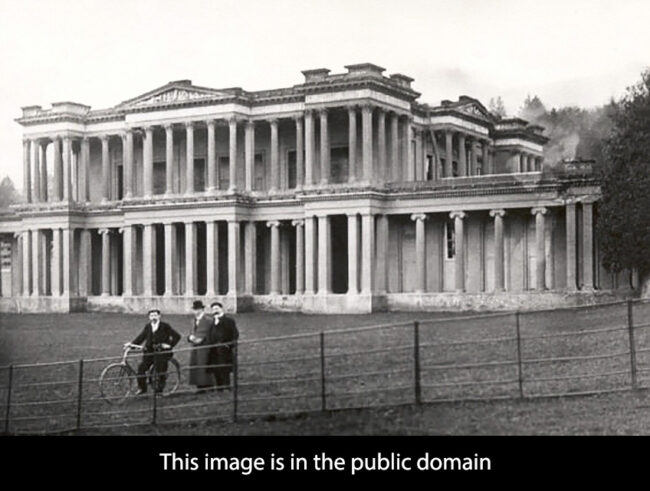
The house from a circa 1895 photograph

The stables in the early 21st century
Built / Designed For: 4th Earl of Egremont
House & Family History: When George Francis Wyndham became the 4th Earl of Egremont in 1837 he did not inherit the family seat, Petworth, the great Sussex country house that had been the seat of Wyndhams since 1750. In response, Lord Egremont took it upon himself to build a new house that would outstrip Petworth in magnificence. He took an existing house called Combesatchfield and hired the architect James Knowles with the directive to create an immense house that would overawe everyone who saw it. Knowles accomplished his client's dictum by encasing the modest house with brick, adding enormous new wings, and covering the whole with a cement render in a classical style, complete with a sculpted frieze of the Exodus of the Israelites into Egypt on the external cornice. The final product was 600 feet long, contained 187 rooms, 130 marble mantelpieces, 150 cellars, and occupied an acre of ground. When the earl died in 1845 the interiors were not completed, though his wife continued to live in a part of Silverton until her death in 1876. Just 25 years later the entire house, considered an awkward white elephant, was pulled down.
Collections: The contents of Silverton Park were auctioned in 1892. This sale surprisingly came to the forefront of the art world in the 2003, when the professional antique dealer and art forger Shaun Greenhalgh sold an ancient Egyptian sculpture to the Bolton Museum in Manchester for £439,767 that had supposedly once been part of the collection at Silverton. Called "The Amarna Princess," the forgery was enabled because the 1892 sale catalog, a copy of which Greenhalgh owned, contained no photographs, only descriptions, of the art to be auctioned. Included in the catalog were a number of unnamed Egyptian statuettes, which made possible the creation of "The Amarna Princess," a translucent alabaster statue in the Egyptian Amarna style of 1350 BC. The 20-inch-tall statuette was said to represent one of the daughters of the Pharaoh Akhenaten and his consort, Queen Nefertiti. Both Christie's and the British Museum confirmed that the statue was authentic. It was Scotland Yard's Arts and Antiquities Unit that broke the case in 2006, when their investigation of the Greenhalgh family led to suspicions that the family were professional art forgers.
Comments: Nikolaus Pevsner and his colleague Bridget Cherry called Silverton "an extraordinary design, entirely clothed in colonnades" in the 1991 edition of "The Buildings of England: Devon."
Garden & Outbuildings: The sole surviving building on the estate is the Neoclassical stableblock, which is owned by the Landmark Trust and used for holiday lets.
Architect: James Thomas Knowles Jr.
Date: 1839-45
Title: Destruction of the Country House, The
Author: Strong, Roy; Binney, Marcus; Harris, John
Year Published: 1974
Publisher: London: Thames & Hudson Ltd.
ISBN: 0500270052X
Book Type: Softback
House Listed: Demolished
Park Listed: Not Listed
Past Seat / Home of: George Francis Wyndham, 4th Earl of Egremont, until 1845; Wyndham family here until 1876.
Current Ownership Type: Demolished
Primary Current Ownership Use: Demolished
House Open to Public: No
Historic Houses Member: No